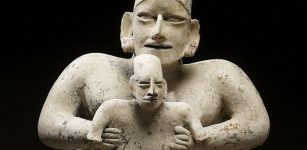Nasca Lines: Researchers Identify 16 Bird Geoglyphs Drawn On Desert Plains Of Peru
Conny Waters - AncientPages.com - Using an ornithological approach, scientists have re-identified the huge birds drawn on the desert plains of Peru as hermits or pelicans. Birds are most depicted animals in the famous lines and geoglyphs of Nasca pampas.
Researchers believe these exotic birds are likely related to the purpose of the etching process.
 The team’s ornithological analysis re-classified a previously identified hummingbird as a hermit. Photo taken by Masaki Eda.
The team’s ornithological analysis re-classified a previously identified hummingbird as a hermit. Photo taken by Masaki Eda.
Ornithological identification of bird geoglyphs found only regionally exotic birds. Hermits and pelicans were etched in geoglyphs of Nasca Pampas, the desert plains of southern Peru around 2,000 years ago. The birds appear to be exotic to the region and further studies could help explain their significance.
The lines and geoglyphs of Nasca and Palpa are located some 400 kilometers south of Lima, Peru and form a World Heritage Site covering an area of about 450 square kilometers.
They were carved into the ground between 400 B.C.E and 1000 C.E. by pre-Inca people, and include lines, geometric designs, and animal and plant drawings. Most of these etchings are so large that they are best seen in aerial photographs. Identifying what they represent is an essential first step towards unraveling the mystery of why they were drawn in the first place.
 Pelican one of many geoglyphs among Nasca Lines. source
Pelican one of many geoglyphs among Nasca Lines. source
Masaki Eda of The Hokkaido University Museum, Takeshi Yamasaki of Yamashina Institute for Ornithology, and Masato Sakai of Yamagata University in Japan identified the 16 bird geoglyphs among more than 2,000 drawings present in the area.
“Until now, the birds in these drawings have been identified based on general impressions or a few morphological traits present in each figure. We closely noted the shapes and relative sizes of the birds’ beaks, heads, necks, bodies, wings, tails and feet and compared them with those of modern birds in Peru,” Eda said in a press release.
Researchers re-classified a previously identified hummingbird as a hermit; and a guano bird and a previously unidentified bird drawing as pelicans.
Other bird drawings that are thought to be condors or flamingos did not have the essential characteristics to validate such identifications, but were too inconsistent with modern Peruvian birds to justify a new classification.
Although the identified birds do exist in Peru, they are found in other parts of the country than where the drawings were made. Hermits, for example, are found in the forests on the eastern slopes of the Andes and in the north near Ecuador. Pelicans live along the coast.
“The Nasca people who drew the images could have seen pelicans while food-gathering on the coast. Our findings show that they drew exotic birds, not local birds, and this could be a clue as to why they drew them in the first place,” explains Eda.
Further research could help identify more of the birds depicted in the geoglyphs, the researchers say.
Written by Conny Waters - AncientPages.com Staff Writer




















